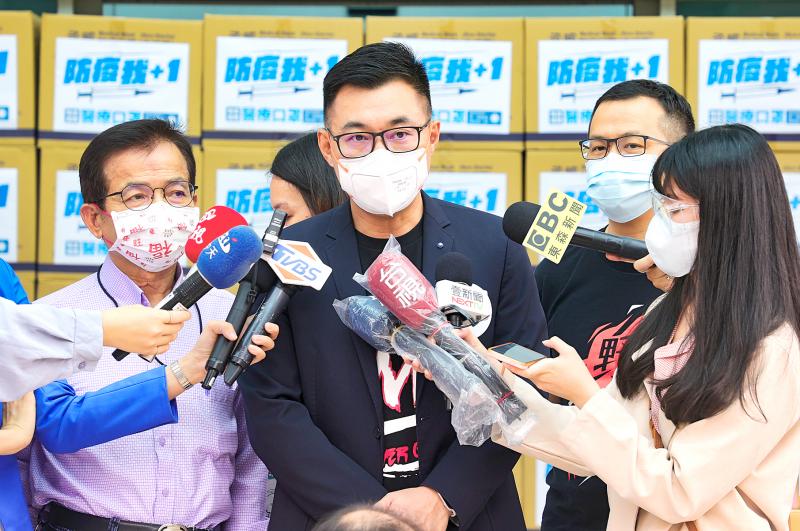Chinese Nationalist Party (KMT) Chairman Johnny Chiang (江啟臣) yesterday said that the US’ and Japan’s donations of COVID-19 vaccines were not due to the efforts of President Tsai Ing-wen’s (蔡英文) administration.
Japan has donated 1.24 million AstraZeneca doses and the US has donated 2.5 million Moderna doses to Taiwan.
While Taiwanese are grateful, officials in the Tsai administration have “the least reason to boast” about the donations, Chiang said.

Photo: CNA
“It is because of the Tsai administration’s policy mistakes that other friendly nations saw the breach in Taiwan’s [COVID-19] situation and sent the vaccines quickly,” he said.
The loss of more than 500 lives led to the donations, he said, referring to the number of Taiwanese who have died from the disease.
The Tsai administration should not consider the donations its “political achievement,” he added.
So far, no official from the administration has taken responsibility for the deaths and stepped down, he said.
He also accused the administration of using the donations for “propaganda” at home and abroad.
“These vaccines came not because of the efforts of the Tsai administration, but because friendly nations heard the calls of Taiwanese,” he said.
On the issue of domestically developed COVID-19 vaccines, Chiang said the government should not treat people like “guinea pigs.”
People would only support the vaccines if they have been internationally approved, he said.
Separately yesterday, the KMT in a statement thanked the Lithuanian government for its announcement of a donation of 20,000 AstraZeneca vaccine doses to Taiwan, saying it “embodies the friendly reciprocity between Taiwan and Lithuania.”
“We’ll always remember your nation’s generosity during these trying times,” Chiang wrote on Twitter.
However, the amount of vaccines Taiwan has acquired is still far from the amount needed to achieve herd immunity, the KMT said.
“Besides merely relying on international donations, the KMT also hopes that the Tsai administration will work harder to procure vaccines and help Taiwan leave the pandemic behind as quickly as possible,” it said.

Taiwanese scientists have engineered plants that can capture about 50 percent more carbon dioxide and produce more than twice as many seeds as unmodified plants, a breakthrough they hope could one day help mitigate global warming and grow more food staples such as rice. If applied to major food crops, the new system could cut carbon emissions and raise yields “without additional equipment or labor costs,” Academia Sinica researcher and lead author the study Lu Kuan-jen (呂冠箴) said. Academia Sinica president James Liao (廖俊智) said that as humans emit 9.6 billion tonnes of carbon dioxide compared with the 220 billion tonnes absorbed

The Taipei Mass Rapid Transit (MRT) Wanda-Zhonghe Line is 81.7 percent complete, with public opening targeted for the end of 2027, New Taipei City Mayor Hou You-yi (侯友宜) said today. Surrounding roads are to be open to the public by the end of next year, Hou said during an inspection of construction progress. The 9.5km line, featuring nine underground stations and one depot, is expected to connect Chiang Kai-shek Memorial Hall Station to Chukuang Station in New Taipei City’s Jhonghe District (中和). All 18 tunnels for the line are complete, while the main structures of the stations and depot are mostly finished, he

Taipei is to implement widespread road closures around Taipei 101 on Friday to make way for large crowds during the Double Ten National Day celebration, the Taipei Department of Transportation said. A four-minute fireworks display is to be launched from the skyscraper, along with a performance by 500 drones flying in formation above the nearby Nanshan A21 site, starting at 10pm. Vehicle restrictions would occur in phases, they said. From 5pm to 9pm, inner lanes of Songshou Road between Taipei City Hall and Taipei 101 are to be closed, with only the outer lanes remaining open. Between 9pm and 9:40pm, the section is

China’s plan to deploy a new hypersonic ballistic missile at a Chinese People’s Liberation Army Rocket Force (PLARF) base near Taiwan likely targets US airbases and ships in the western Pacific, but it would also present new threats to Taiwan, defense experts said. The New York Times — citing a US Department of Defense report from last year on China’s military power — on Monday reported in an article titled “The missiles threatening Taiwan” that China has stockpiled 3,500 missiles, 1.5 times more than four years earlier. Although it is unclear how many of those missiles were targeting Taiwan, the newspaper reported